The Tilton Downtown Historic District
Introduction
Text-to-speech Audio
Images
North Side of Main Street incl. Charles E. Tilton Block, Bank Block, Alfred Tilton Block, and the Side of Tilton Block. Steeple of Northfield-Tilton Congregational Church visible above Alfred Tilton Block by Roger P. Akeley on December 15, 1982
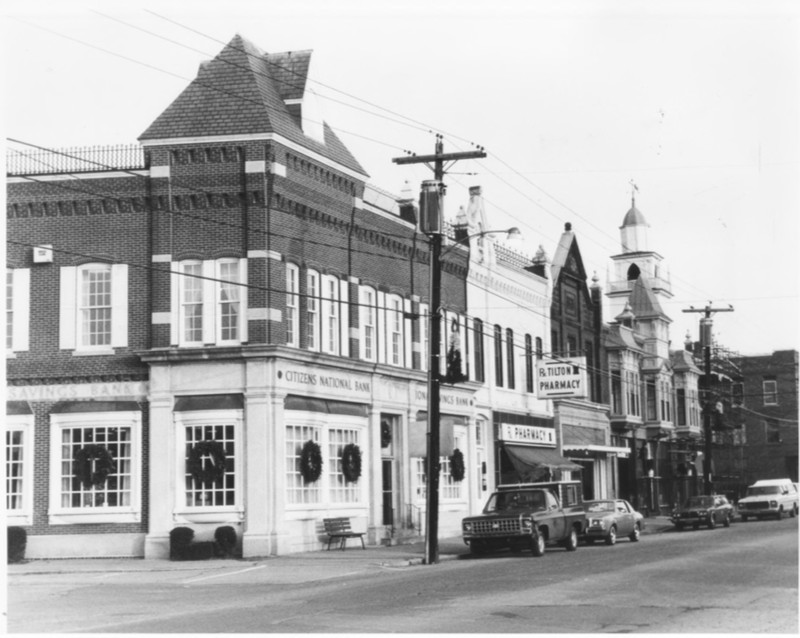
Northfield-Tilton Congregational Church by Roger P. Akeley on December 15, 1982
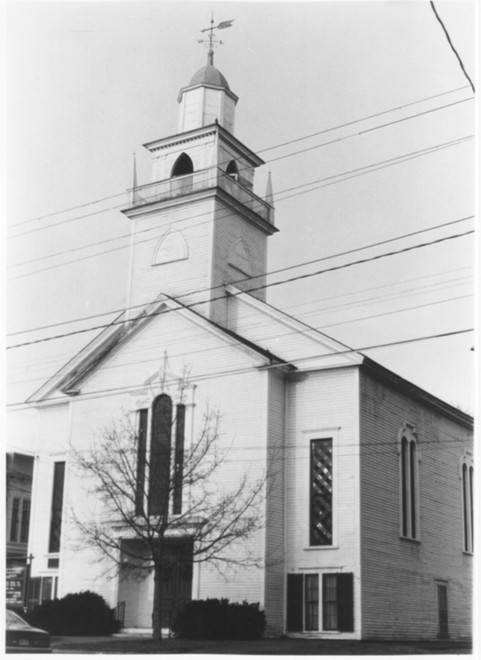
South Side (2) of Main Street incl. Meserve's Store, Copp Block, Page Block, and Bryant and Lawrence, Inc. by Roger P. Akeley on December 15, 1982
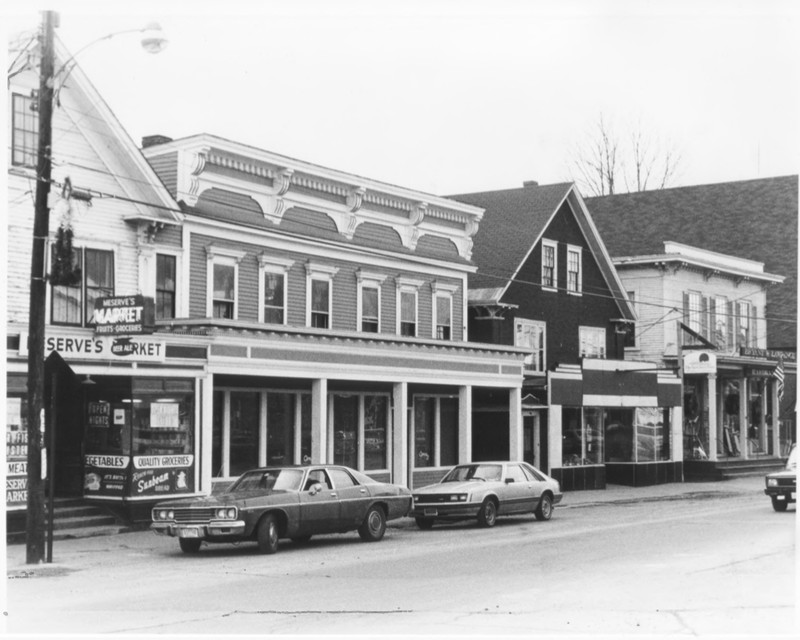
South Side (3) of Main Street incl. Trinity Episcopal Church, Bryant and Lawrence, inc., and Copp Mill 3 by Roger P. Akeley on December 15, 1982
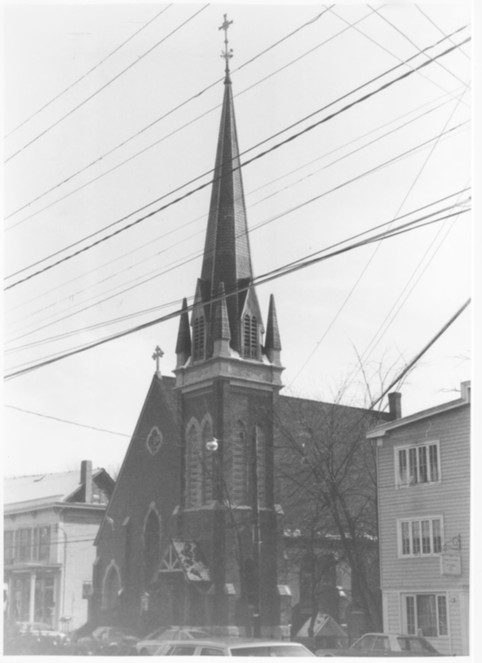
South Side of Main Street incl. Coop Gristmill, Copp Mill 3, Meserve's Store, Copp Block, Page Blick, Bryant and Lawrence, Inc., and the Trinity Church by Roger P. Akeley on December 15, 1982
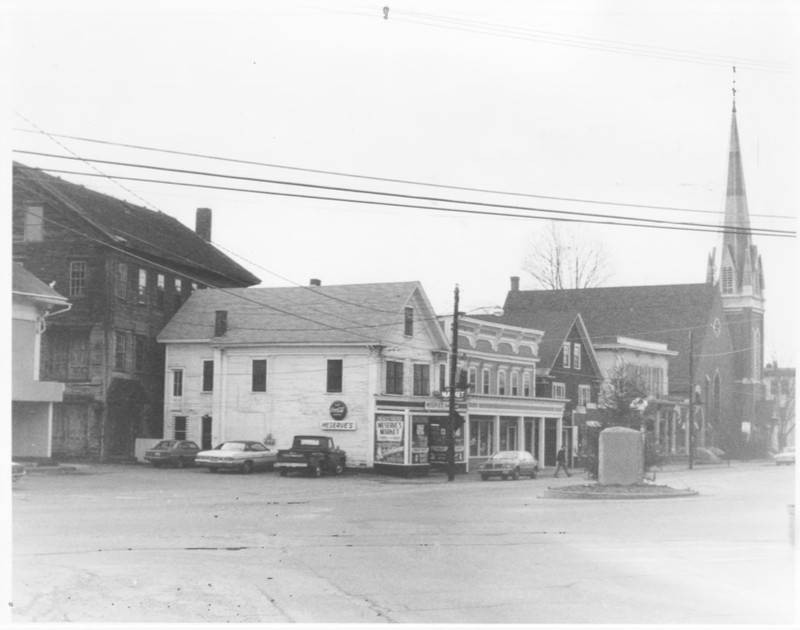
Statue of America at the Entrance of Veterans Square by Roger P. Akeley on December 15, 1982
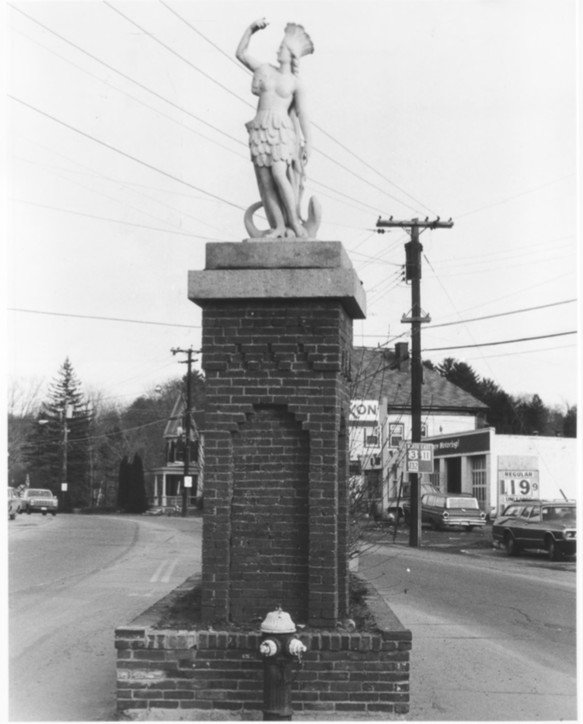
The South Side of the Tilton Block and Lovering Block by Roger P. Akeley on December 15, 1982

Tilton Town Hall, Tilton Inn, World War I Monument and Statue of America by Roger P. Akeley on December 15, 1982
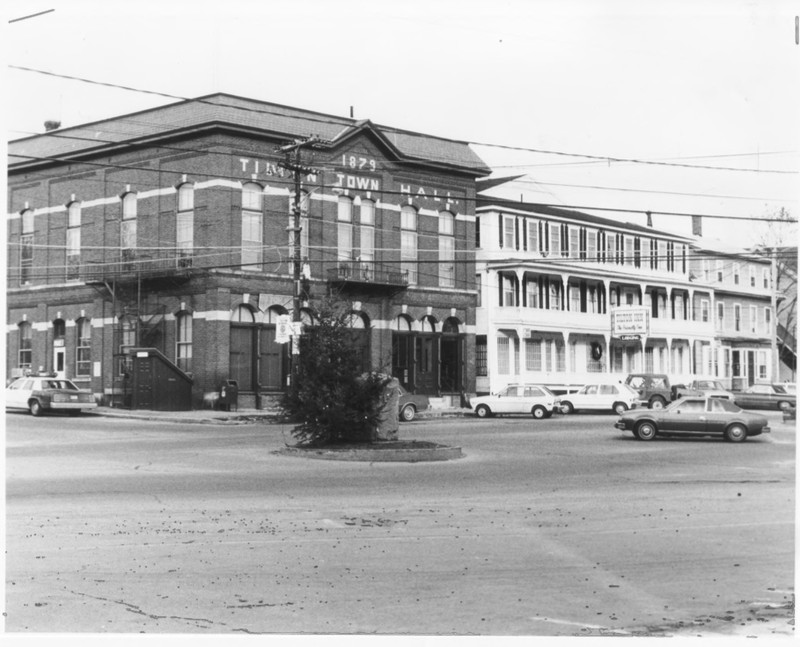
Backstory and Context
Text-to-speech Audio
The Town of Tilton began its history as a neighborhood of the Town of Sanbornton known as Sanbornton Bridge. Sanbornton Bridge had the makings of a future commercial district, with a central road located aside the Winnipesaukee River. Sanbornton itself was founded shortly after the French and Indian War, with the original settlers organizing the construction of a road from nearby Canterbury, New Hampshire. Following the laying of the road, the original Sanbornton Bridge was constructed, which would continue to serve the town until the 20th century.
Mills were the backbone of the riverside town, with the first mills being constructed in 1765 and 1766 near the Sanbornton Bridge. Main Street was properly structured and designated as a public highway in 1772. Interestingly, most of the major roads in Tilton, Sanbornton, and Franklin (the three towns that Sanbornton split into over the last two centuries) to this day still correspond to the roads that branched off of Main Street.
Main Street became an important district for commerce and industry, with a number of businesses rising around it throughout the late 1700s and the early 1800s. For decades, though, Sanbornton Bridge was simply a small neighborhood of the much larger Sanbornton. It was the rise of a number of textile mills and other mills. These mills brought business and new citizens to Sanbornton Bridge.
Sanbornton Bridge was transformed in the mid-1800s by Charles Tilton’s investments in the Boston, Concord, and Montreal Railroad. Sanbornton Bridge became the home of a railroad station for the line, which helped further establish the town as a center of its own. In the decades following the construction of the railroad station, a number of public buildings were funded and constructed along Main Street. A number of churches rose around this time as well, including the Methodist Church and the Congregational Church.
In the late 1800s, Sanbornton Bridge declared its independence from Sanbornton and incorporated as Tilton, named in honor of Nathaniel and Charles Tilton. Tilton gained a number of new mills throughout the decades following its incorporation as an independent town. The commercial district flourished and many of the older buildings were renovated. This wave of restructuring is the reason that much of the Historic District now is comprised of post-Civil War structures, many in the Victorian architectural style, which was growing incredibly popular in the area at the time.
Charles E. Tilton’s influence on the town is most visible in the buildings that he funded at the turn of the century. Tilton funded the Tilton Town Hall, the Statue of America, the Charles E. Tilton block, and the Alfred Tilton Block, in addition to a number of public parks in the area. Charles E. Tilton’s development of the town would prove to be the greatest period of thriving and growth for the town.
The 20th century was a quieter century for the city of Tilton, though the notable construction of the World War I Monument did occur in 1919. Unfortunately, a number of the buildings that originally stood along Main Street were either demolished or severely renovated prior to the District’s addition to the National Register of Historic Places. Lost buildings include the Railroad Station, the Methodist Church, and the Hotel Loverin.
Thankfully, preservation efforts have ensured that many key buildings of the old commercial district still remain to this day. The buildings included within the Historical District are listed in detail below, as numbered in the official documentation:
1. Copp Gristmill
The Copp Gristmill, named after its owner and commissioner Hazen Copp, was constructed in 1872. The mil still retains some of its original styling to this day, despite undergoing a significant renovation in the 1960s. The greatest changes to the building involved the removal of some of the windows and the modification of other windows, as well as the addition of a modern-styled fire escape along one side of the building. The Copp Gristmill is still home to segments of original clapboarded exterior, the original gable roof, and one remaining original window.
2. Copp Mill No. 3
Another mill belonging to and commissioned by Hazen Copp, Mill No. 3 lies to the west of the Copp Gristmill and was built in 1877. Partially due to an 1889 renovation which added another floor to the mill, Copp Mill No. 3 stands a full two stories above its predecessor. Though Mill No. 3 did not remain a mill for much of its life, having been converted into a shoe factory during its 1889 renovation, its original appearance was preserved considerably well. The siding, doors, and windows of the lower stories were updated throughout the late 1900s, but the interior has remained unchanged. Additionally, no changes to the layout of the building have been undertaken since 1889.
3. Meserve’s Store
The exact date of construction of Meserve’s Store is unknown, but estimates based on photographs have placed its construction date sometime between 1859 and 1883. Originally, Meserve’s Store was a two and a half story building, but a third story was added in the early 1920s as an expansion of the store space. Though not particularly ornate, the storefront has been maintained in its original stylings, though the current storefront is not the same storefront as the building had at construction.
4. Copp Block
The Copp Block represents another piece of Tilton’s downtown commissioned by Hazen Copp. It was built in 1894 to house a store and, similarly to its neighbors on the street, was renovated in the early 1900s in order to add a third story to the store and again in 1982. The 1982 renovation added a porch and removed the original storefront. These two exterior renovations make the Copp Block particularly unique in that all three of its floors now represent completely different time periods. Copp Block stands out among its neighbors in that it is the more ornate of the shops along Main Street, featuring architectural flourishes few other buildings nearby have.
5. Page Block
Another building with an unsure date of construction, it was likely built around the same time as Meserve’s Store. Page Block’s exterior has been heavily changed from its original appearance, though the storefront still maintains some of its original features. The interior has been preserved reasonably well, but, unfortunately, the Page Block’s exterior appearance has largely been lost to time.
6. Bryant and Lawrence, Inc.
Much like Page Block and Meserve’s Store, the specific date of construction of Bryant and Lawrence, Inc. is unknown, though it is known to have been business a considerable amount of time before 1881 but after 1859. One of the most interesting facts about this building is the fact that the same firm has operated in the building since 1882. The Bryant and Lawrence building was changed at various times through the early 1900s, though it was restored to its original appearance in 1971, following older photographs as blueprints for the restoration. It is now an almost perfect match for its appearance in the 19th century.
7. Trinity Episcopal Church
Designed by notable architect Edward Dow of Concord, NH, the Episcopal Church was designed following the conventions of the Gothic Revival style of church design. The construction of the Trinity Episcopal Church took approximately one year, starting in 1872. Interestingly, the iconic wooden spire of the Church, which towers above the Town of Tilton, was not present at its construction. The tower for the spire was built, but the spire was not actually added for nearly a decade.
Almost no additions or modifications have been made to the building, save for an early 1900s addition of a furnace room and kitchen to the back of the building. As a result of its impeccable preservation, Tilton’s Trinity Episcopal Church stands as one of the best Gothic Revival churches in New Hampshire.
8. Charles E. Tilton Block
A Victorian-style commercial building with an out-of-character Classical-styled bank front punctuating its appearance, the Charles E. Tilton Block has been preserved reasonably well, in spite of the addition of the Classical front. The Block was originally built in 1886 at the commission of Charles E. Tilton, though it was later sold and split into two halves, each occupied by different businesses. The bank that took control of the western half, the Citizens National and Iona Savings Bank, chose to remodel the front of the building in 1926 to the Classical style now displayed. The upper stories and the eastern half, however, have gone largely unchanged, minus a change in the paint coloration on the eastern side.
As a result, the Charles E. Tilton Block is a strange, but relevant building that displays well-preserved aspects from the early 1900s and the late 1800s.
9. Bank Block
Another building renovated in the Classical style by the Citizens National Bank and the Iona Savings Bank, the Bank Block was originally a humble building that was small in comparison to the buildings next to it. It was repeatedly expanded or renovated, with the most significant being the addition of a detailed Classical Style front in the early 1900s.
Much like the Charles E. Tilton Block, both the Victorian and Classical aspects of the building are well-preserved and high-quality, meaning that it is an unconventional mixture of odd appearance that is still historically relevant in regards to architecture.
10. Alfred Tilton Block
Constructed in 1887, just one year after the construction of the Charles E. Tilton Block, this brick Victorian-style commercial building was given by Charles E. Tilton to his son Alfred. The Alfred Tilton Block represents one of the finer buildings on Main Street, having considerably more flourish and decoration than its neighbors. The Block underwent significant restoration during the 1980s under the commission of Iona Savings Bank, who had hoped to correct what few changes did occur to the Block over the years.
11. Northfield-Tilton Congregational Church
The Northfield-Tilton Congregational Church holds the prestigious position of oldest surviving building on Main Street. The Church was constructed in 1838 and has undergone surprisingly little exterior change. The two major changes, which occurred in the late 1800s, came in the form of the raising of the Church by one story to add a vestry and the extension of the central sections of the Church. These renovations maintained the style of the church, and were only intended to add more functional space for the church.
12. Tilton Block
The Tilton Block (not to be confused with the Charles E. Tilton and Alfred Tilton Blocks,) was constructed for Charles E. Tilton’s other son, Charles Jr, in 1915. It features four independent storefronts on Main Street which are decorated by ornamental strips of vertically-laid bricks. One of the more simplistic structures in the Historic District, the Tilton Block is likely to be more interesting to historians looking for a glimpse into everyday commerce in the early 1900s than to visitors looking to be entertained by ornament.
13. Loverin Block
The Loverin Block stands on the site of one of Tilton’s previously most recognizable features: the Hotel Loverin. The Hotel burned to the ground in July of 1903 and the Block was built in its stead a year later at the commission of J.L. Loverin. With six storefronts on Main Street included in the Loverin Block, it is one of the wider buildings on the street. J.L. Loverin intended to rebuild the hotel in the vacant lot beside the new Loverin Block, but this project was never undertaken. As a result, the eastern side of the Loverin Block was never improved in appearance. The building that now stands in the once-vacant lot next to the Loverin Block is exempted from inclusion in the Historical District.
14. Tilton Town Hall
Completing construction in 1880, the Tilton Town Hall was paid for in full by Charles E. Tilton to serve the town. Interestingly, Tilton citizens did not vote to accept the gift – and its conditions – until a few months after the Tilton Town Hall’s construction. One of the conditions of the gift, perhaps speaking better to Charles E. Tilton’s desire for immortalization via monument than anything else in the Town, was that the Town accept to never change its name.
Charles E. Tilton’s gift to the city was a fantastic Victorian-style public building that has been fantastically preserved to this day. Only a few minor modifications have ever been made to the building, few of which would be noticeable to anyone not searching for them specifically.
15. Tilton Inn
The Tilton Inn is a building whose many modifications seem to tell more of a story than the architectural features of the building itself. While it is now a single building, the Tilton Inn was once two separate buildings that neighbored one another. The dates of construction of the buildings are unknown, though photographic analysis has placed the time of their construction between the years of 1875 and 1879.
It is known that a fire in June of 1875 burned the buildings that inhabited the lot previously to the ground and that, sometime shortly thereafter, two buildings were raised in the lot. The eastern building was specifically constructed to be a hotel and underwent two major modifications sometime in the early 1900s which added a story to the building and a two-story porch. Finally, at some point between 1912 and 1923, the western building was purchased and connected to the eastern structure.
Currently, the building appears early 20th-century in style, and there is little to nothing that would point to the buildings ever having been separate at all save for older photographs of Main Street.
16. Veterans Square
Veterans Square contains two important monuments that have brought character to the downtown for decades each. The first of these monuments is the Statue of America. Being presented to the Town in 1872, the Statue of America belonged to a set of statues which represented the “Four Continents of Earth.” Three of these statues still stand today. Interestingly, the Four Continents statues match two identical sets which are located in Philadelphia and Louisiana. No artist has been credited on any of the sets, though local newspapers noted that the set “was purchased of an English artists of great repute.”
The Four Continents statues were donated to the Town by Charles E. Tilton. The Statue of America appears to be a Native American Princess dressed in traditional feathered regalia. She holds a bow in one hand and is standing over a carving of an alligator.
The second monument in Veterans Square is the World War I Monument, which was constructed by the Town of Tilton in 1919. A simple, rough rectangular block with a bronze plaque, the World War I Monument memorializes a number of World War I soldiers who hailed from Tilton.Sources
NPS NRHP Photographic Documentation for the Tilton Downtown Historic District. National Park Service. June 14, 1983. Accessed October 01, 2017. https://npgallery.nps.gov/GetAsset/6efbbe37-ae44-4c63-8bd3-c301b0887162/. NPS NRHP Photographic Documentation for the Tilton Downtown Historic District
